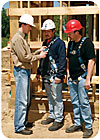
Technology is impacting our lives and our jobs at almost every turn. Now, new technology developments are bringing even the fall protection product category into the information age, helping safety professionals more effectively manage their programs.
Whether responsible for one manufacturing plant or a series of oil rigs, safety pros all face a common challenge: making sure that every piece of safety equipment issued for a job is up-to-date, properly inspected, will arrive at the job on time and will be in compliance.
While fall protection is a technical field, much of the technology deployed to date has primarily been mechanical in nature. With the adoption of digital technologies such as radio-frequency identification (RFID), this new technology is fast becoming a valuable tool in the fall protection industry. The effects of RFID technology are new product development considerations, system support and, ultimately, greater safety compliance and business value for end-users.
Because the fall protection industry is highly regulated, the use of new technology is frequently driven by standards and regulatory changes. Interestingly, the adoption of RFID is unique in that it is being driven by a technology solution, not simply a standards change. RFID technology affords safety professionals a solution that promotes business value as well as better safety compliance.
Built into FP equipment
While RFID has been used in a wide variety of applications worldwide, it is now being used to increase the safety of workers who require fall protection equipment. Rugged RFID-enabled devices, or tags, are built into fall protection equipment such as harnesses, lanyards and self-retracting lifelines and read by electronic readers that scan and account for the equipment through a tracking system, such as a unique serial number. Radio waves emitted by the passive RFID tags travel from the chip to the receiving device, transmitting a variety of coded information. The tag’s information is activated by the scanner’s electromagnetic waves and then tracked through a personalized Web portal, providing immediate access to safety and equipment information, inspection checklists, industry regulations, training records, product advisories and other useful links.This personalized Web portal allows the user to download or view this information quickly on a PDA. Information detailing items such as the history of the equipment, including make, model, date of manufacture, upcoming and past inspection dates, worker assignments, user manuals and safety regulations, becomes easily accessible.
Given that there is a large presence of existing fall protection equipment that is not RFID-enabled, retrofit kits are becoming available for equipment without the RFID tag built in. These kits allow RFID to be enabled on virtually any piece of fall protection equipment.
Inspection capabilities
The capability to track fall protection equipment and inspection records is a great benefit to companies. Use of RFID technology gives a company inspection capabilities that provide them up-to-date inspection logs for product reliability and safety. The system alerts the manager when an item is due, or overdue, for an inspection. This verification capability has enabled equipment managers to promote compliance and to have an electronic record for tracking and auditing immediately on hand.From an inventory control perspective, businesses now know where equipment is assigned and have the ability to make those assignments on multiple levels. Inventory can be assigned to worksites around the globe, and once on the site, to a specific worker. With RFID, misplacement of valuable equipment is less common, and the paperless asset management capability with simple information retrieval is invaluable.
Information management
The use of RFID technology in fall protection is growing as safety professionals seek solutions that improve individual safety behaviors as well as a company’s overall safety compliance. By combining RFID-equipped fall protection with a Web-based information management system, technology dramatically simplifies the management of safety programs through inspection tracking, inventory control and information management. Indeed, the fall protection equipment category has entered into the information age.SIDEBAR: RFID FAQs:
Will the RFID signal wear out? RFID tags have no battery that can limit their life.Are RFID tags like barcodes? The tags differ from barcodes in three significant ways: first, they are more durable and are not susceptible to dirt, grease and grime; second, they do not require a direct line of sight — they can be read from the back, front or side of the product; third, RFID tags can be read from greater distances than are normally required with barcodes.
Can RFID tags cause sparks or interference with equipment? No. The RFID transponder tags do not operate at high enough energy levels to cause a sparking hazard. The tag is read when reached by the electromagnetic waves of the reader.